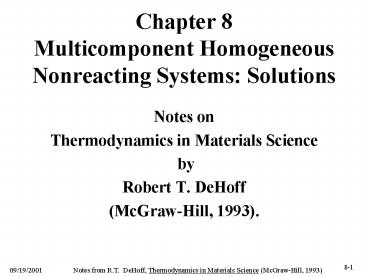Chapter 8 Multicomponent Homogeneous Nonreacting Systems: Solutions PowerPoint PPT Presentation
1 / 29
Title: Chapter 8 Multicomponent Homogeneous Nonreacting Systems: Solutions
1
Chapter 8Multicomponent Homogeneous Nonreacting
Systems Solutions
- Notes on
- Thermodynamics in Materials Science
- by
- Robert T. DeHoff
- (McGraw-Hill, 1993).
2
Extensive Quantities of theState Functions F/,
G/, H/, S/, U/, V/
- Using G/ as example
A differential form of G/
and at constant T P
3
Partial Molal Quantities of theState Functions
.
- Using as example
A differential form of G/ (use definition of
)
and at constant T P
4
Gibbs-Duhem Equation
- The contributions of the components sum to the
whole
Differentiating the products on the right yields
Inspection yields the Gibbs-Duhem equation
For a binary system
5
Reference States F/O, G/O, H/O, S/O, U/O, V/O
- T, S, V, P have absolute values.
- F, G, H, U have relative values.
- The difference in values between states is
unique. - To compare values, use the same reference state.
- Superscript O refers to the reference state.
Rule of mixtures.
- Preferably, for a solution use the pure
components in the same phase as the solution as
the reference state.
6
Rule of Mixtures
For binary
Extensive
Molar
For binary
Rule of mixtures
7
Mixing Values for SolutionsDF/mix, DG/mix,
DH/mix, DS/mix, DU/mix, DV/mix
- For solution Gibbs free energy of mixing.
For component k Change experienced when 1 mole
of k is transferred from its reference state to
the given solution.
Contributions of the components add to the whole
and
8
Mixing Values
Rule of mixtures
9
Mixing values for SolutionsDF/mix, DG/mix,
DH/mix, DS/mix, DU/mix, DV/mix
- Differential form
0
Gibbs-Duhem
0
Total derivative
Gibbs-Duhem for mixing
10
Graphical Evaluation of Partial Molal Values
- Consider a binary system (alloy)
Note
Substitute rearrange
and
11
Derivation Graphical Evaluationof Partial Molal
Values
12
Integration of the Gibbs-Duhem Equation(s)
- For a binary system (alloy)
and
Integrating the left side from X2 0 to X2
0
Now integrate right side
13
Molar Values of the State Functions
- Note
Then,
14
Chemical Potential of (Open) Multicomponent
Systems
15
Chemical Potential of (Open) Multicomponent
Systems
16
Activities and Activity Coefficients
- Definition of activity, ak (dimensionless)
Definition of activity coefficient, gk
(dimensionless)
If gklt1 akltXk k is less apparent than its
mole fraction. gk1 akXk k is as apparent as
its mole fraction. gkgt1 akgtXk k is more
apparent than its mole fraction.
17
Ideal Solution
- No heat of mixing.
No volume change.
No change in internal energy.
Entropy increases.
Helmholtz free energy decreases.
Gibbs free energy decreases.
18
Ideal Solution
T
19
Ideal Solution
- All plots (e.g. DGmix vs. Xk) are symmetrical
with composition. - Slopes of plots of DSmix, DFmix, DGmix are
infinite at Xk 0 Xk 1. - Entropy of mixing is independent of temperature.
20
Ideal SolutionActivity is the same as mole
fraction. Activity coefficient is one.
1
a2
a1
Slope 1
0
X2
0
1
21
Dilute SolutionsRaoult Henrys Laws
- Raoults Law for the solvent in dilute solutions
Henrys Law for the solute in dilute solutions
22
Real Solutions Relation of Activity Coefficient
to Free Energy
- Ideal partial molal free energy of mixing
Excess partial molal free energy of mixing
23
Regular Solution
- Heat of mixing is a function of composition, only.
Entropy is the same as for ideal solution.
Helmholtz free energy decreases.
Gibbs free energy decreases.
24
Regular Solution
T
25
Regular Solution
T
26
Regular Solution
27
Regular Solution
T
28
Regular Solution
T
29
Problem 8.6 DeHoff
Find
Given
Rewrite in general form
Differentiate
Substitute dX1-dX2
Substitute X1X21
Gibbs-Duhem

